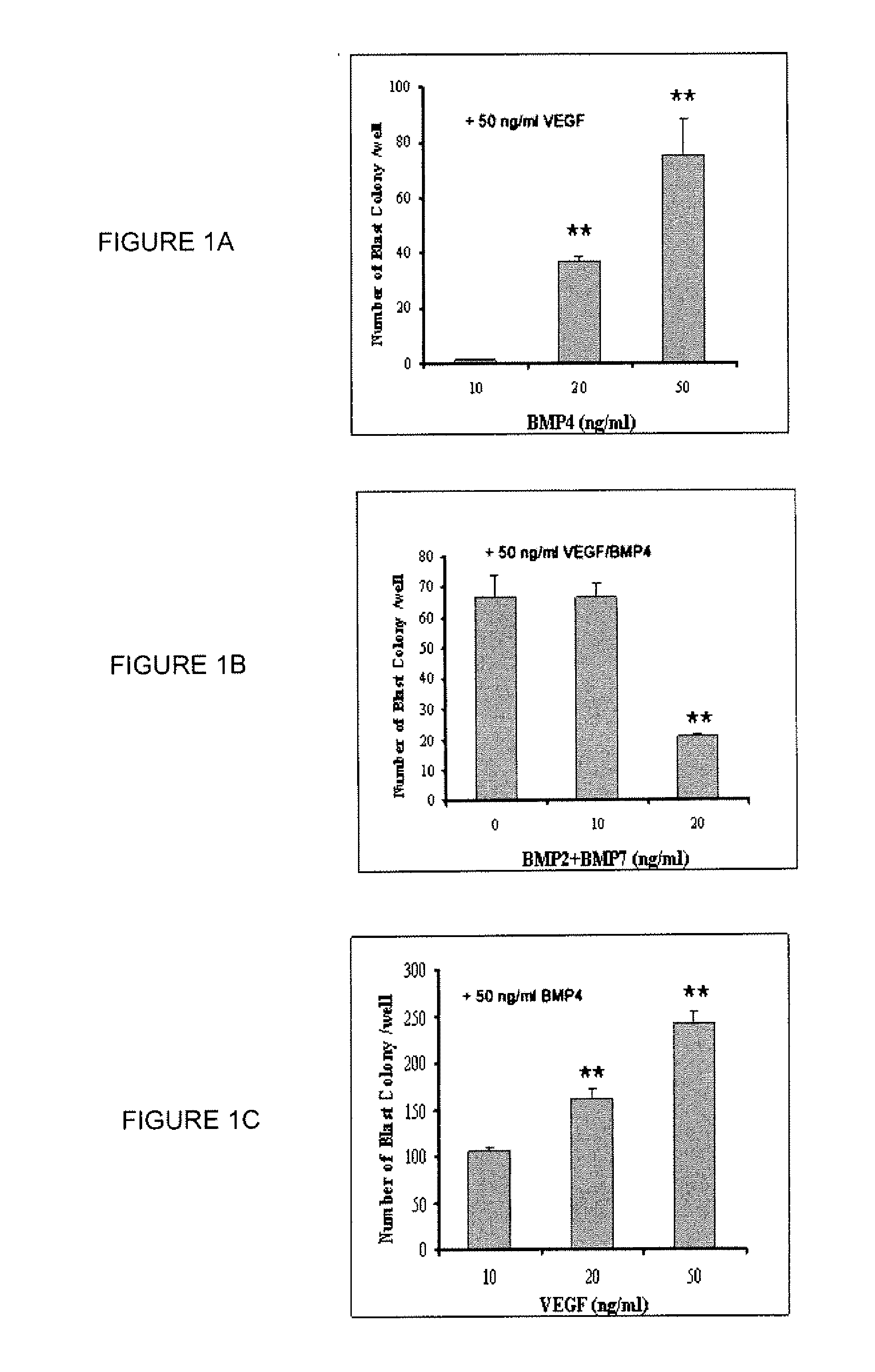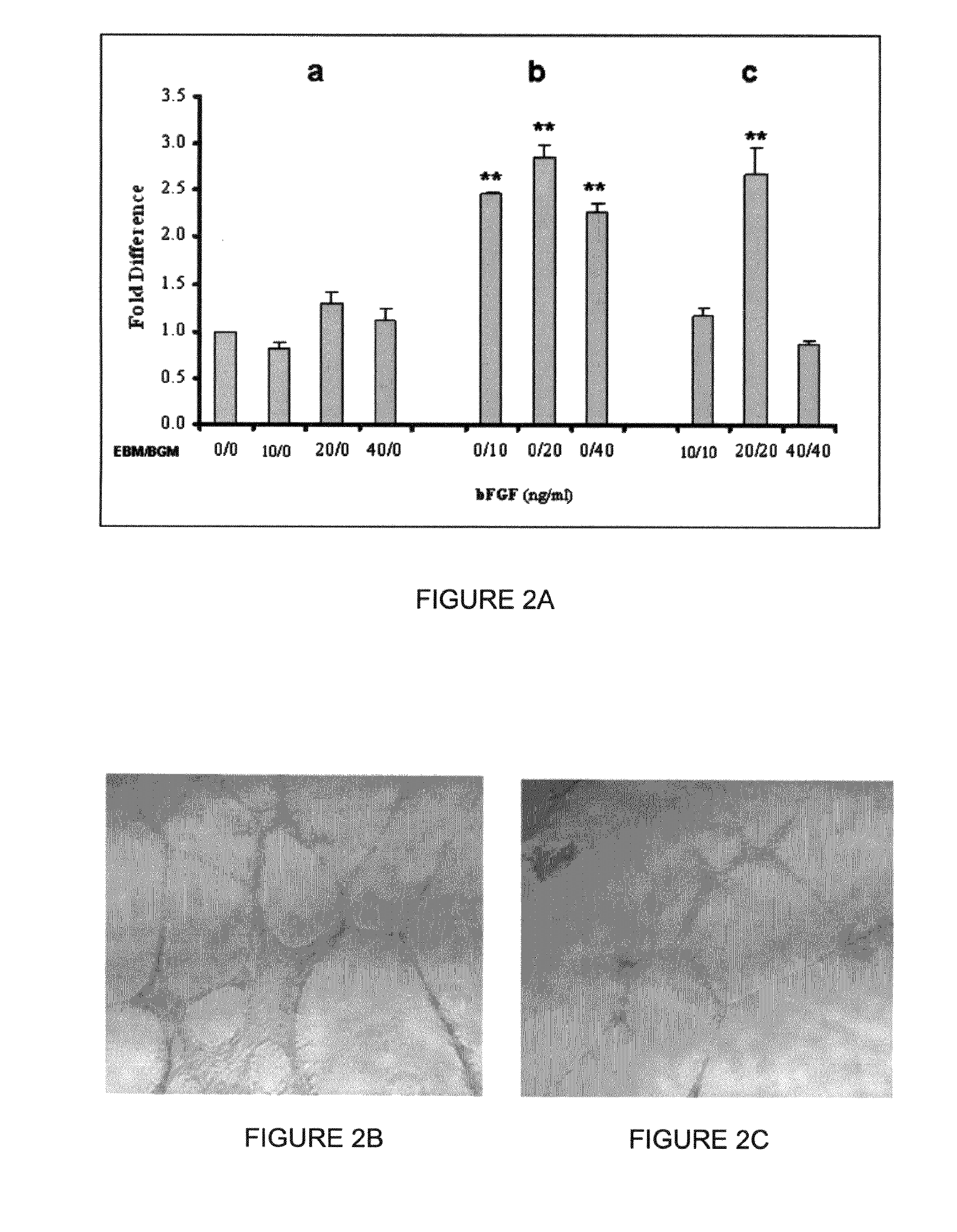Hemangio colony forming cells and non-engrafting hemangio cells
a technology of forming cells and hemangio cells, which is applied in the direction of drug compositions, extracellular fluid disorders, immunological disorders, etc., can solve the problems of not preventing rejection, limited hscs sources, and insufficient hscs, so as to induce tolerance in recipients
- Summary
- Abstract
- Description
- Claims
- Application Information
AI Technical Summary
Benefits of technology
Problems solved by technology
Method used
Image
Examples
example 1
Materials and Methods
[0425]Culture of hESCs
[0426]hESC lines WA01(H1), HUES3, and MA01 were used and maintained as previously described(6). Briefly, hESCs were grown on mitomycin C-treated mouse embryonic fibroblast (MEF) in complete hESC media. The hESCs were passaged every 3-5 days before reaching confluence using 0.05% trypsin-0.53 mM EDTA. For feeder-free culture, the cells were then grown on hESC-qualified Matrigel matrix (BD Biosciences) in complete Modified TeSR™1 (m TeSR™1) medium (Stem Cell Technologies, Inc), which is based on the formulation of Ludwig et al(7,8). Cells were maintained according to manufacture's suggested instructions. Briefly, cells were passaged when they reached approximately 90% confluence, usually every 5-7 days with split ratios ranging from 1:3 to 1:6. Cells were treated with dispase (1 mg / ml BD, Biosciences) and incubated for 3-5 minutes at 37° C. to begin dislodging the colonies. Colonies were washed with DMEM / F12 (Mediatech) to remove dispase solu...
example 2
Both BMP-4 and VEGFs are Required for Hemangioblast Development
[0432]A serum free system to induce hESC differentiation toward the hemangioblastic and hematopoietic lineages was previously described(2,10). Although BMP-4, VEGF, and a cocktail of early hematopoietic cytokines were used, the absolute requirement and optimal concentrations of the individual factors were not examined. In order to reduce the expense and effort necessary to generate hemangioblasts for future research and clinical applications, the inventors specifically examined the minimal requirements and effects of VEGFs, BMPs, and three early hematopoietic cytokines (TPO, FL and SCF) on the efficient development of blast colonies from hESCs. It was found that BMP-4 is absolutely required for the development of blast colonies under serum-free conditions. No blast colonies were obtained without the supplement of BMP-4 in the medium during EB formation and a clear dose-response effect of BMP-4 was observed for the format...
example 3
bFGf Promotes the Growth, but not Commitment, of Hemangioblasts From hESCs
[0434]Previous studies have shown that supplement of bFGF during early differentiation promotes murine and human ESC hematopoietic development(12,13,14,5). Thus, we investigated whether the addition of bFGF during the EB differentiation stage would enhance blast colony formation from hESCs. Addition of bFGF during EB formation had no effect on the development of blast colonies, and, in fact, at a higher dose (40 ng / ml) inhibited the formation of blast colonies from multiple hESC lines (FIG. 2A and FIG. 3). In contrast, the addition of bFGF in BGM significantly enhanced the development of blast colonies (FIG. 2A, FIG. 3). Both the number of blast colonies (p8 BCs from one six-well plate of high quality WA01 hESCs (approximately 1.2×107 cells) after 6 days growth, which is 8±1 fold higher than that obtained from BGM without the supplement of bFGF.
[0435]To investigate the lineage differentiation potentials of BCs...
PUM
| Property | Measurement | Unit |
|---|---|---|
| volume | aaaaa | aaaaa |
| periods of time | aaaaa | aaaaa |
| periods of time | aaaaa | aaaaa |
Abstract
Description
Claims
Application Information
 Login to View More
Login to View More - R&D
- Intellectual Property
- Life Sciences
- Materials
- Tech Scout
- Unparalleled Data Quality
- Higher Quality Content
- 60% Fewer Hallucinations
Browse by: Latest US Patents, China's latest patents, Technical Efficacy Thesaurus, Application Domain, Technology Topic, Popular Technical Reports.
© 2025 PatSnap. All rights reserved.Legal|Privacy policy|Modern Slavery Act Transparency Statement|Sitemap|About US| Contact US: help@patsnap.com



